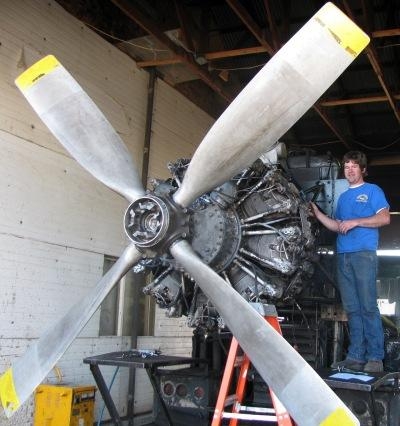Pratt & Whitney R-2800 Double Wasp Runs On Swift's
100SF
A company based in the Purdue Research Park has completed an
informal round of testing of its high-octane, unleaded, sustainable
aviation gasoline in an unmodified World War II-era radial engine.
More than 100 gallons of Swift Enterprises' 100SF powered an
unmodified Pratt & Whitney R-2800 Double Wasp engine during
three days of testing conducted at Anderson Aeromotive Inc. in
Grangeville, Idaho. Test results showed that 100SF produced a
higher detonation onset threshold than 100LL. The engine was
operated at 115-145 octane takeoff power settings and there were no
indications of engine knock.

Ron Adams, performance lead at Swift Enterprises, said the tests
were conducted to evaluate 100SF's ability to meet the needs of
pilots who fly critical missions using large radial engines. "Some
remote communities in Alaska and other areas of the world are
inaccessible by ground transportation, and they depend on aircraft
powered by large radial engines to bring essential supplies," he
said. "To date, these engines posed a significant barrier for any
alternative aviation fuel because they demand high-octane gasoline
to produce their design horsepower. We wanted proof that 100SF can
shatter that barrier."
The tests were conducted by FAA Airframe and Powerplant (A&P)
mechanics Dave Ormond (pictured with Double Wasp engine), who also
holds inspection authorization, and John Lambert. Anderson
Aeromotive is operated by Ray Anderson and Bob Nielsen, who have
more than 70 combined years of radial engine experience. Anderson
explained why he and his colleagues agreed to test the gasoline.
"The need to replace our present leaded avgas with an
environmentally friendly alternative is obvious," he said. "We are
happy to cooperate in this effort to continue to evaluate 100SF,
and we look forward to the next round of testing."

Adams said Norman Koerner, president of TriCap International
Inc., was the catalyst needed to make the testing possible. "Norm
is an invaluable asset - an international MD-11 captain, and
FAA-certificated A&P mechanic with subject-matter expertise in
the field of warbirds and the engines that power them," Adams said.
"He approached us some years ago with the commitment to test 100SF
and has been unrelenting in identifying, organizing and scheduling
all the participants in these tests. We owe Tri-Cap International
and Anderson Aeromotive a tremendous debt of thanks."
Koerner has had a longtime interest in flying aircraft with
large radial engines and knew the leaded fuel needed to operate
them was under scrutiny. "Learning that Swift Enterprises and
Anderson Aeromotive shared this concern, it was natural to arrange
the initial testing that has now proven that 100SF is most
definitely a candidate for further testing," he said.
100SF will undergo another, more intense and formal round of
radial engine testing in 2012 as funding becomes available. Tri-Cap
International will be the lead, but the date and location are yet
to be confirmed.
"The next phase, which will include further detonation, ADI and
pressure carburetor work, will pave the way for commercial
operators of legacy aircraft - who burn more than 10 percent of the
avgas used in the United States - to continue providing their
essential service," Koerner said. "Additionally, 100SF will be able
to power the heritage aircraft that are indispensable in preserving
the history of World War II." (Photo provided by Ron Adams)
 ANN's Daily Aero-Term (05.19.24): Back-Taxi
ANN's Daily Aero-Term (05.19.24): Back-Taxi Aero-News: Quote of the Day (05.19.24)
Aero-News: Quote of the Day (05.19.24) Aero-News: Quote of the Day (05.20.24)
Aero-News: Quote of the Day (05.20.24) ANN's Daily Aero-Term (05.20.24): Blind Speed
ANN's Daily Aero-Term (05.20.24): Blind Speed ANN's Daily Aero-Linx (05.20.24)
ANN's Daily Aero-Linx (05.20.24)




